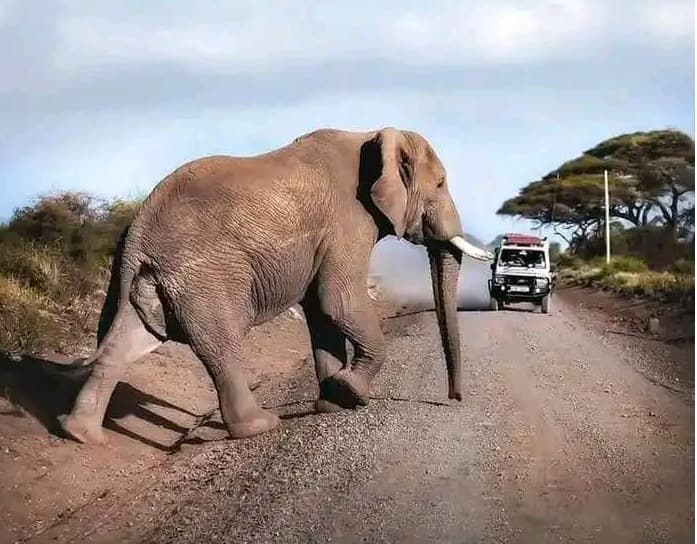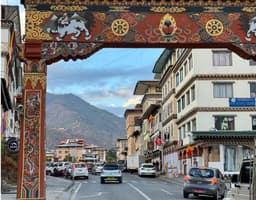Introduction to the Everest Base Camp Trek
Ever thought of having a peaceful journey being in the tranquility of lush nature? And if yes, it comes out with the thought of the allure of silent and peaceful landscapes, inside the nature far from the modern bustle! Isn’t it sound like journey in the Himalayas. And if Himalayas, it obviously mostly, sounds like the trail of Everest Base Camp Trek!
And yes! The Everest Base camp trek is already a sensational trekking scenario and a very chosen among the travel enthusiasts as well adventure seekers from the 4-side corners of the world. The journey in unspoiled nature of Himalayas offering the best of high-altitude landscapes along with the natural and the traditional immersion of preserved practice from the centuries back by the ethnic communities making it a travel story in itself.
Everest Base Camp Trek is now not only the destination, it’s the once in a lifetime bucket list for the most of travel enthusiasts and the persons who seeks to spend time along the nature and inside its tranquil atmosphere.
It offers the diverse ecosystem of nature, bio-diversity, lush greenery, and the culture of Himalayan people along with the hub for local Sherpa cuisines. It makes Everest Base Camp Trek, already once in a lifetime journey to be in and feel the nature with your own palm.
To being one of the wide choices for the trekkers and travelers, Everest base camp trek blends the immersion of attractive travelling aspects such as,
- The spectacular view of snowcapped mountain range including the highest in the world like Mt. Everest, Mt. Cho Oyu, Mt. Lhotse and the following range
- The stunning views of glaciers, icefall, and lakes
- The majestic scenery of landscapes of alpine forest, bending rivers and layer hills,
- Diverse wildfire and bio-diversity of flora and fauna,
- Scenic Traditional village surrounded by the farming terrace as well the vibrant Sherpa towns and settlements,
- Cultural practice which are preserved from the centuries back
- Wildlife encounters that are rare and endangered as well only survives or habitants in high-altitude
- Wide range of delicious local cuisines and some of the foreign dishes
Where Is Everest Base Camp Trek?
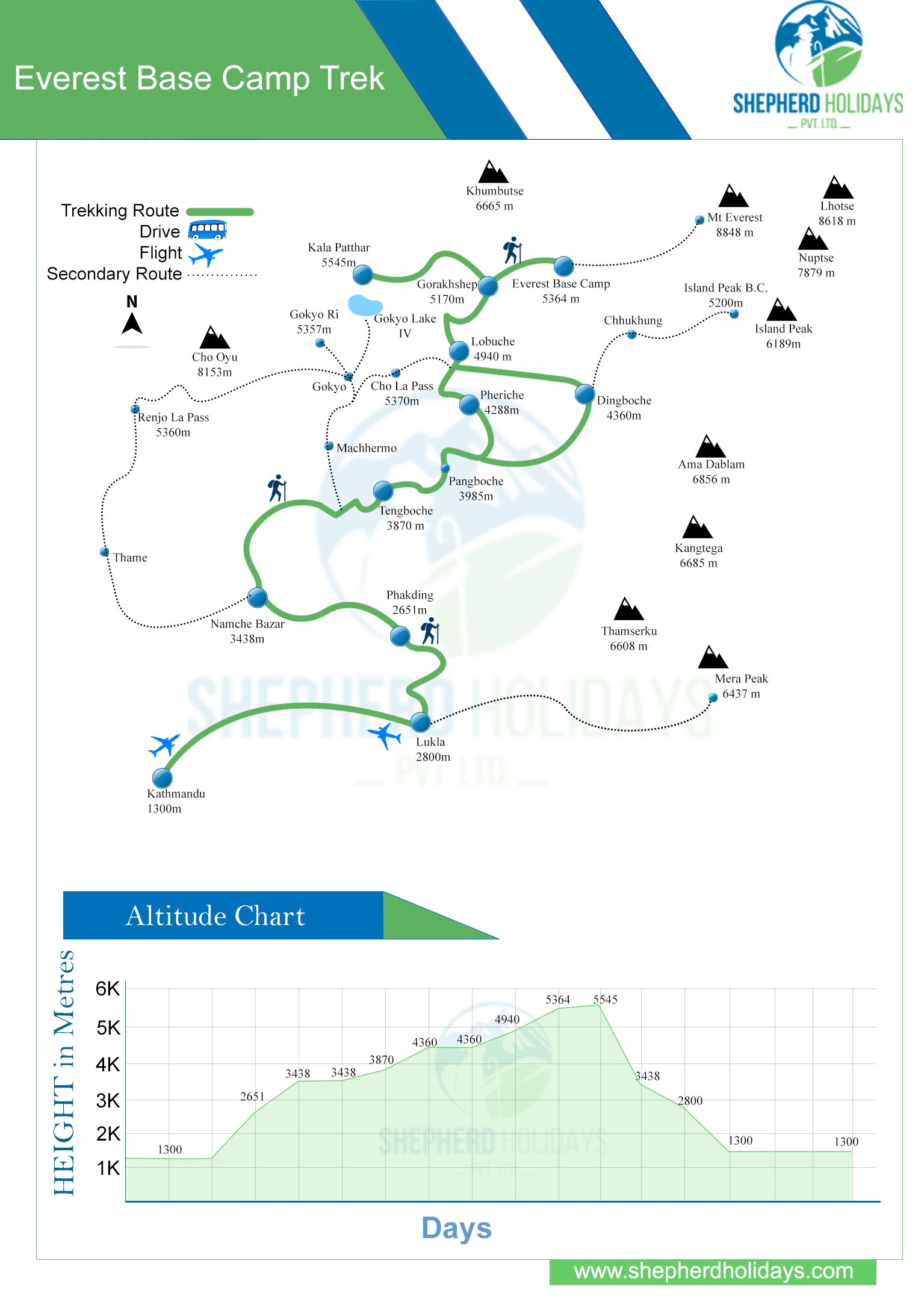
The trail of Everest Base Camp trek is drawn over the preserved region of Sagarmatha National Park which lies inside the Solukhumbu, District of Northen Nepal. The region is also popular with its name Everest Region or the Khumbu Region, holds the enormous preserved and the unspoiled nature.
Specifications
Location
Region : Everest Region/Khumbu Region
Preservation Area : Sagarmatha National Park
District : Solukhumbu, Nepal
Altitude
Highest : 5,644m at Kala Patthar
Lowest : 2610m at Phakding (vary open location and alternative trails)
Gateway : 2860m (usual gateway of Lukla)
Everest Base Camp : 5364m
Best time to trek for Everest Base Camp Trek
Nepal is always open for travelling as different seasons, all throughout the year offers unique and different experience bringing the various features along them. The landscapes also offer the different taste of journeys. It makes Nepal a very flexible choice too, besides the factors of weather. But it’s the matter of personal preference as well the features which a traveler wants to enhance in their journey.
So, considering the features as well the topography of Khumbu Region, Spring and Autumn is taken and picked as the best seasons to be in there. It also comes out from the recommendations as well the most chosen for the best tome in Everest Base Camp Trek by different trekkers from different parts of the world.
Spring
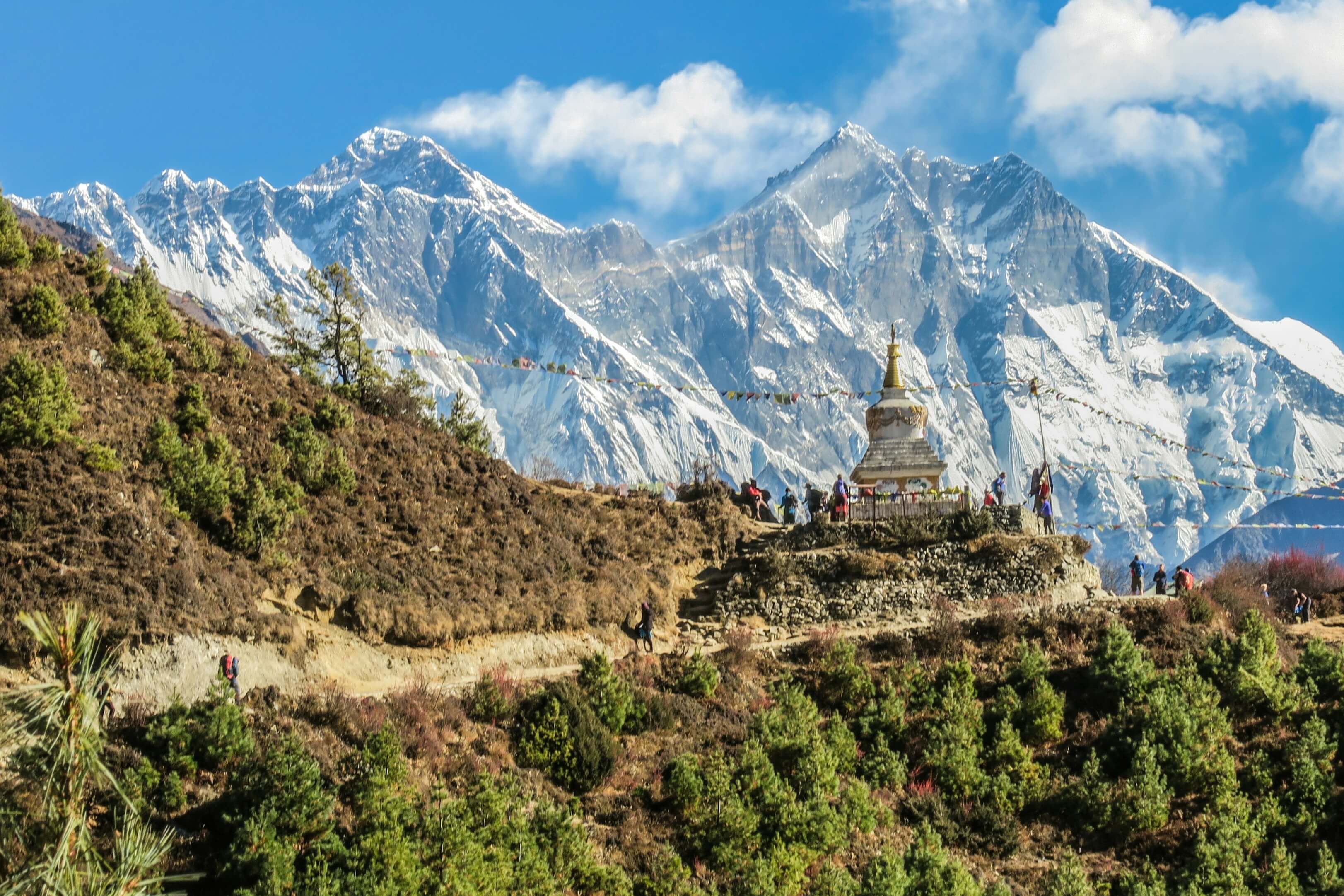
During the blossoming season of Spring, blooming flowers and the lush greenery plays the important role in making it a great time. The weather also gest stable and the freshening nature after the pre-monsoon rain adds more flavor. The visibility will be clearer than most of the other seasons. So, in overall, the Spring season offers the scenic and the refreshing journey along with the scenic trails, to choose Spring as the best time for Everest Base Camp Trek.
Features
- Stable weather
- Scenic landscapes with blossoming wild
- Refreshing nature after the fresh pre-monsoon rain
- Ideal temperature
- Longer days
Cons
- Considered to be the peak season for arrival of trekkers
- Could be crowed trail somewhere
Autumn
In the time of Autum, the trails all over the Everest Region gets its colorful time of the year due to the falling season of dry leaf. The warm hue during the season too offers a mesmerizing journey and a very picturesque route. The weather will be it at its most stable stage of the year. The visibility also gets clearest of the year. And also, during this time you can also touch the biggest festival of Nepal, Dashain and the festival of lights Tihar to immerse yourself inside the cultural and traditional immersion of Nepal. In overall journey, you will be getting the mesmerizing and a very picturesque journey during this season to choose it as the best time for Everest Base Camp Trek.
Features
- Most stable weather
- Clearest visibility of the year
- Mesmerizing journey with the colorful trail and warm hue
- Major festivals of Dashain and Tihar, biggest in Nepal
- Ideal temperature
Cons
- Peak season of the year for the trekking due to the enhancing features similier to Spring
- Crowed trail may be the encountering issue for you
Everest Base Camp Trek Route Overview
There are different routes which can be taken to cover the journey of Everest Trek to get there in Everest Base Camp Trek. The traditional one and the other alternative too are the choices to enhance your journey as of your preference.
Popular Route for Everet Base Camp Trek
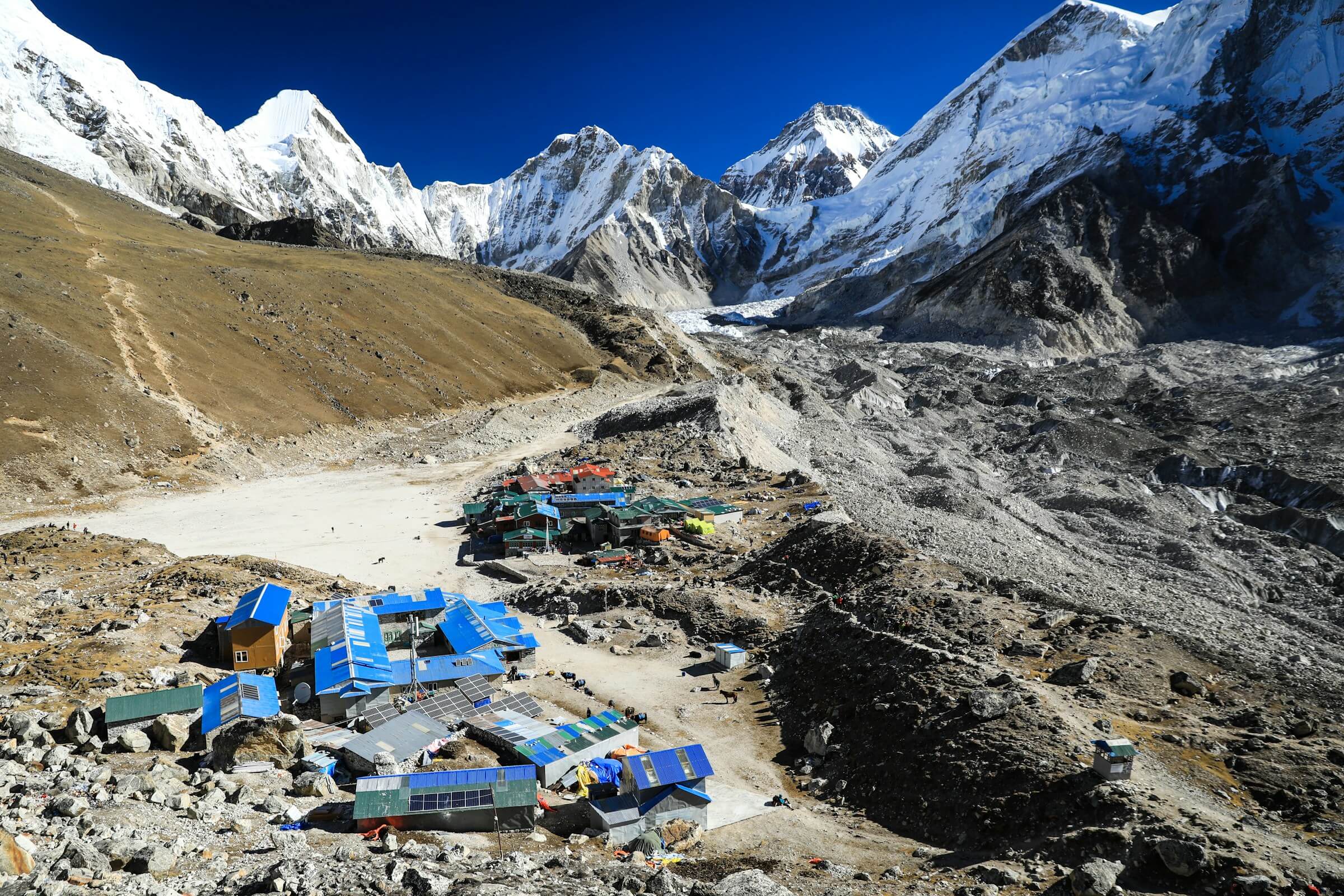
Day 1: Lukla to Phakding
Altitude: 2840m to 2610m
Duration: 3 hours
Day 2: Phakding to Namche Bazer
Altitude: 2610m to 3440m
Duration: 5 hours
Day 3: Namche Bazer to Tengboche
Altitude: 3440m to 3860m
Duration: 6 hours
Day 4: Tengboche to Dingboche
Altitude: 3860m to 4410m
Duration: 5 to 6 hours
Day 5: Dingboche to Lobuche
Altitude: 4410m to 4940m
Duration: 6 hours
Day 6: Lobuche to Ghorekshep
Altitude: 4940m to 5164m
Duration: 4 hours
Day 7: Ghorekshep to Everest Base Camp and back to Gorekshep
Altitude: 5164m to 5364m
Duration: 3 hours
Day 8: Gorekshep to Pheriche via Kala Patthar
Altitude: 5164m to 5664m at lala patthar to 4371m at Pheriche
Duration: 7 to 8 hours
Day 9: Pheriche to Namche Bazer
Altitude: 4371m to 3440m
Duration: 7 hours
Day 10: Namche Bazer to Lukla
Altitude: 3440m to 2840m
Duration: 8 hours
Optional
Everest Bade camp Trek Via Gokyo Lake
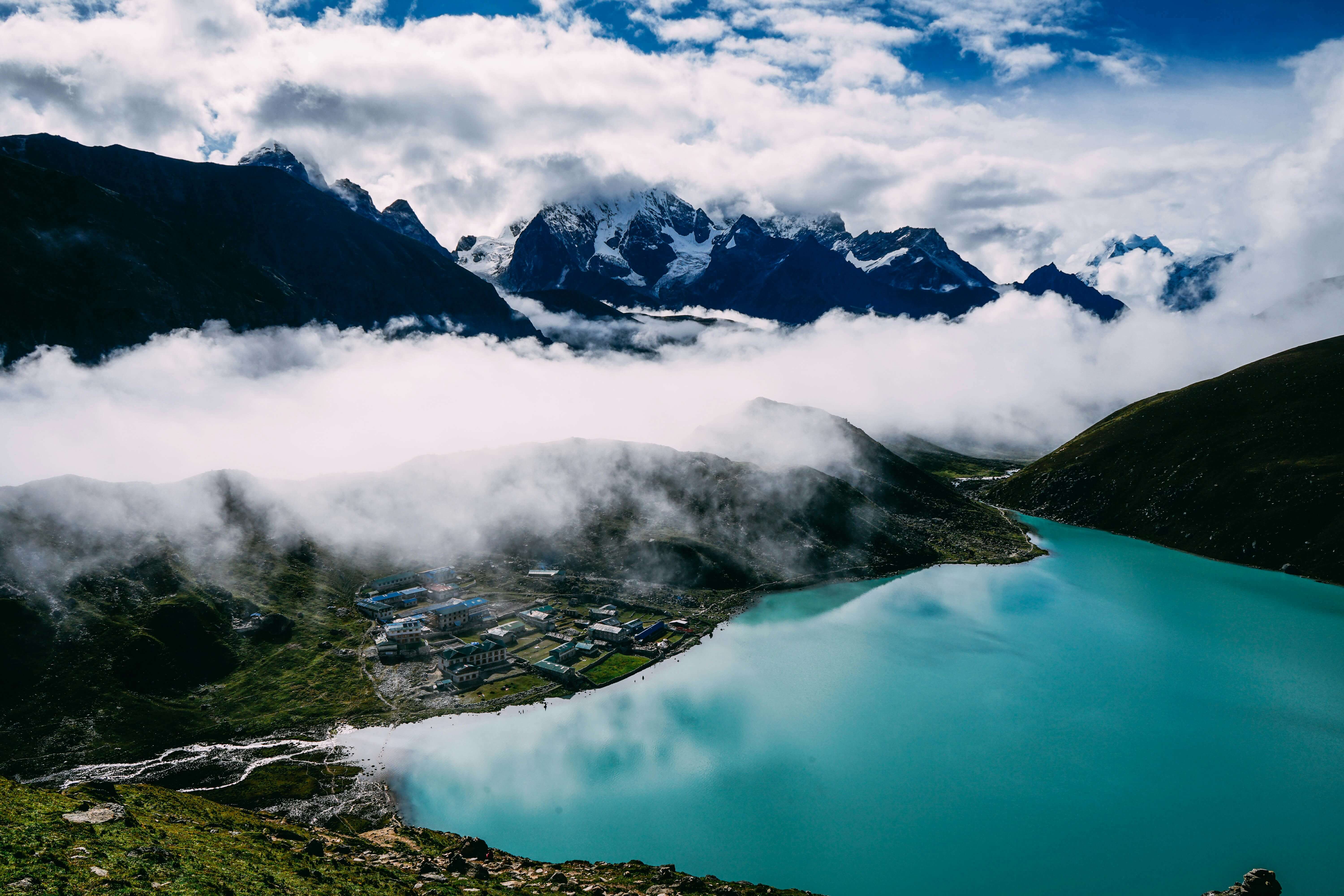
Day 1: Lukla to Phakding
Altitude: 2840m to 2610m
Duration: 3 hours
Day 2: Phakding to Namche Bazer
Altitude: 2610m to 3440m
Duration: 5 hours
Day 3: Namche Bazer to Phorste Thang
Altitude: 3440m to 3840m
Duration: 5 hours
Day 4: Phorste Thang to Macchermo
Altitude: 3840m to 4470m
Duration: 5 hours
Day 5: Macchermo to Gokyo Lake
Altitude: 4470m to 4700m
Duration: 6 hours
Day 6: Gokyo Lake to Gokyo Ri
Altitude: 4700m to 5357m
Duration: 6 hours
Day 7: Gokyo Ri to Dole
Altitude: 5357m to 4038m
Duration: 6 hours
Day 8: Dole to Namche Bazer
Altitude: 4038m to 3440m
Duration: 7 hours
Day 9: Namche Bazer to Lukla
Altitude: 3440m to 2860m
Duration: 6 hours
Everest Base camp trek via Gokyo Ri and Chola Pass
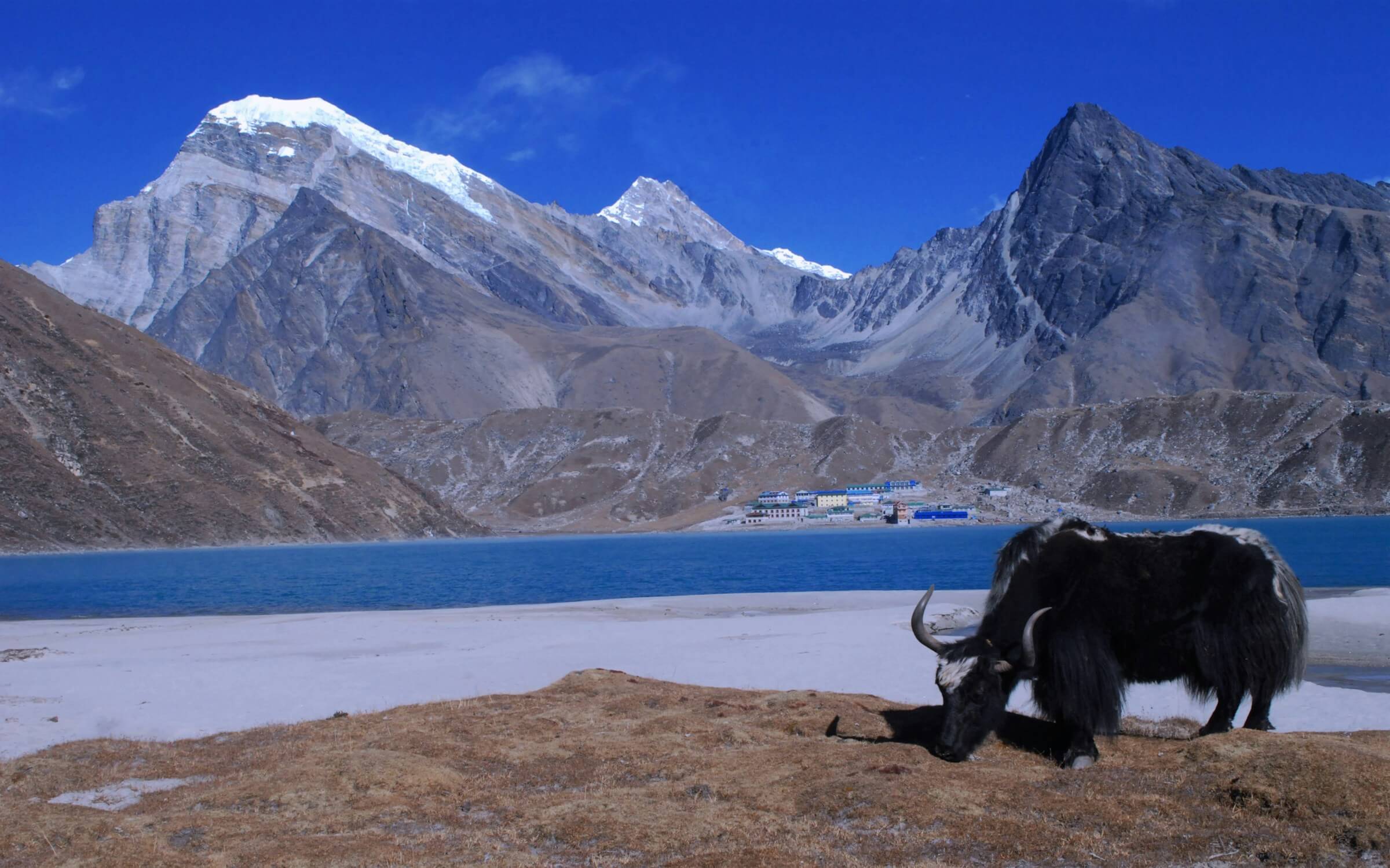
Day 1: Lukla to Phakding
Altitude: 2840m to 2610m
Duration: 3 hours
Day 2: Phakding to Namche Bazer
Altitude: 2610m to 3440m
Duration: 5 hours
Day 3: Namche Bazer to Dole
Altitude: 3440m to 4038m
Duration: 6 hours
Day 4: Dole to Machhermo
Altitude: 4038m to 4470m
Duration: 6 hours
Day 5: Machhermo to Gokyo Ri Lake
Altitude: 4470m to 5357m
Duration: 5 hours
Day 9: Gokyo Ri Lake to Thaknak
Altitude: 5357m to 4750m
Duration: 5 hours
Day 10: Trek to Dzongla via Cho-La Pass
Altitude: 5740m to 5420m at Cho-La pass to 4830m
Duration: 8 hours
Day 11: Dzongla to Lobuche
Altitude: 4830m to 4940m
Duration: 4 hours
Day 12: Lobuche to Gorek Shep to Everest Base camp and return to Gorek Shep
Altitude: 4940m to 5164m
Duration: 8 hours
Day 13: Gorek Shep to Pheriche via Kala Patthar
Altitude: 5264m to 5644m at kala patthar to 4371m
Duration: 8 hours
Day 14: Pheriche to Namche Bazer
Altitude: 4371m to 3440m
Duration: 7 hours
Day 15: Namche Bazer to Lukla
Altitude: 3440m to 2860m
Duration: 7 hours
There are several diverse routes to get there and to do the Everest Base camp Trek. Above are the picked some of the differently drawn routes which covers the diversity of high-altitude nature and its geography.
Here, in Shepherd Holidays, we covered and conducted all the trekking routs which are available in Everest trekking. There are multiple short and long trekking trails which equally offers the diverse journey.
All of the itinerary packages we offer are curated and well-designed from our past experience from the past decades and with expertise of our staffs in field from very long ago. So, all are managed and built with considering the proper safety and care of trekkers with us.
Here are too some of other trekking packages which we provide relate to or connected to Everest Base Camp,
Everest Base Camp via Salleri
Everest Base Camp Helicopter Tour
Everest Base Camp with Multiple Handing
Note: the duration of trekking journey can be varied accordingly to the customizable option we provide, because we care our trekkers and respect each interest to conquer the Himalayas in their own way customizing the acclimatation, staying and exploring.
Difficulty Level of EBC Trek and Who Can Do It?
The difficulty of Everest Base Camp Trek depends upon personal ability and the past experience in the trekking journeys. It also depends upon the routes and the alternative trail you choose to complete the Everest trekking journey.
For the beginners it could be a difficult journey if you do not have any trekking experience before.
For the experienced one it still depends upon the trail you choose, it can vary from moderately-difficulty to moderate level of trekking journey.
But still it can be done with the interest in you and the will-power to experience one of the best terrain journeys in the Himalayas. And also, it gives you an opportunity to challenge yourself and conquer the adventure spirit inside your own. And don’t forget it’s an adventure in challenging journeys.
Who’s its ideal for?
It’s ideal for the person who are physically fit and the age between 10 to 60 plus as well the first timer too even if it brings some difficulty. Difficulty is the adventure.
Still a point to consider, the persons who have disabilities have too done and successfully completed the Everest Base camp trek. So, as mush as you have that spirit to conquer your own inner challenge, the Everest Base Camp trekking Journey is open for you and will always be welcoming.
Some Training Tips
- You can do the basic breathing exercise for the better outcome pioneer from 1 month of trek
- You can do some walking and jogging exercise too
Permits and Regulations for EBC Trek
The Everest Base Camp trekking trail is drawn inside the preserved area of Sagarmatha National Park which falls under the Everest or the Khumbu region. So, you need to have some of the proper permit works from the board issued by the government of Nepal. It is mandatory and strict under the rules and regulation of preserved region of Everest. He following are the permits you need to have during your EBC trek,
- TIMS (trekking Information and Management System)
- KPLRMP (Khumbu Passang Lhamu Rural Municipality Permit
- SNPEP (Sagarmatha National Park Entry permits)
Where to get?
You can get them from the Nepal Tourism Board or can be taken from the gateway in Lukla. The valid passport and legal documents and the necessary legal personal information.
The charges is a bit varied according to the nationality as follows:
Sagarmatha National Park Entry Permits
Foreigners: NPR 3,000 (approximately USD $30) per person
SAARC citizens: NPR 1500 per person
Nepalese Citizens: NPR 100 per person
Children under 10: Free
Khumbu Pasang Lhamu Ruler Municipality Permit
Foreigners: NPR 3000 (approximately USD 30 $) per person
SAARC citizens: NPR 1500 per person
Nepalese Citizens: NPR 100 per person
Children under 10: Free
Accommodation Food and Drinks For EBC Trek
The accommodation facilities in Everest trail differs from standard to basic and luxury to standard in some locations too considering the huge arrival of tourist every year.
But the popular one is the teahouse accommodation due to its traditional blend in its services, which gives trekkers a chance to experience the local lifestyle from close immersion and within their own. The producers of preparing and serving of local cuisines and dishes too are done in teahouses and homestays making it more interesting and a very authentic experience of Himalayas.
To know more about teahouse treks, you can visit to our another guide for Teahouse treks in Nepal.
The menu in Everest region consists of mostly the authentic Nepali cuisines and dishes, such as Dal Bhat, Dhedo Tarkari, Roti, Mo; Mo, soups, Chaw Mein and other wide range of locally prepared and locally originated cuisines.
Due to the popularity of Everest Base Camp Trek, some restaurants and cafes even offer you the foreign dishes such as pizza, pasta, burger, nuggets and more in such remote location and higher altitude.
And even if you are vegan, the teahouse and restaurants are open to provide you the non-veg free foods drinks, even in some places with the gluten-free options.
Most of the teahouse in such remote locations and in such high-altitude where modern infrastructure does not exist and all goods are transport through the means of animals and porter, leading to the basic services. So, recommended not to complain over the basic services and try to adjust if you are only familiar to the standard or the luxury ones.
But basic services and the teahouse accommodations is one of the best and the most authentic way of experiencing the Himalayan life.
What to Pack for the Everest Base Camp Trek
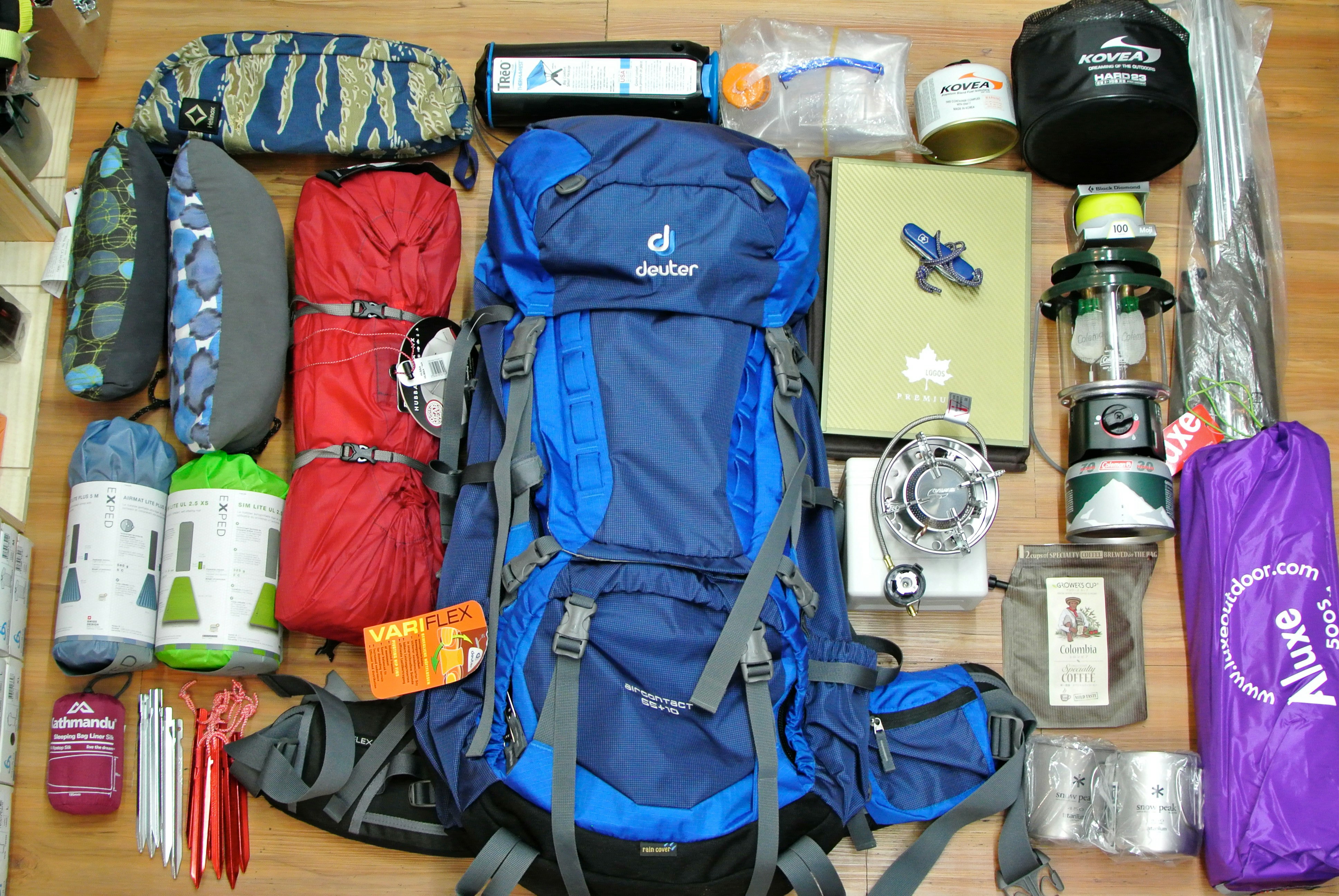
With all the information above, you may guess Everest trek mis a bit diverse trekking journey, in point of its geography and journey too. So, it needs a bit of preparation. You need to have proper gears and proper clothing as well as essentials as for you need before you head to the trekking trail, below are some of the given gear checklists to recommend you for your easier access or the ideas of what to take and what to pick for EBC trek,
Gear Checklist
- Backpack
- Water bottle
- Trekking boots
- Trekking pole
- Torch light
- Knife
- Sleeping bag
- Toiletries
- First Aid Kit (important)
- Gloves (optional)
- Glasses (optional)
You can add more gears as of your essential and what you think is often useful for you during your journey.
Tech Gear Checklist
- Solar banks
- Water purifiers
- Offline GPS
Same here, you can add more gears as of your essential and what you think is often useful for you during your journey.
Note: Do not carry so much essentials which you are not going to use often during your journey. Only carry as much as you need and what you consider you will be going to need/use often during your journey. Unusual packing just increases the weight of your backpack and it can possibly just ruin your whole experience. So, it is recommended to have the effective and the efficient checklist for your essentials.
Altitude Sickness and Health Tips
Altitude Sickness usually is a cautious thing after you ascend above or once you gain the altitude of 3000m from the sea level. And the journey of Everest Base Camp covers the trail up to the altitude of 5644m, so it is very necessary to keep the precautions and cautious about the altitude sickness which is often seen as one of a vital factor to tackle during the high-altitude journey.
Here you can see some of important points to consider during your journey to prevent and avoid the risk of altitude sickness,
Altitude Sickness Symptoms
- Headache
- Loss of appetite
- Nausea
- Nose bleeding
- Vomiting
- Fatigue
Preventions
- Keep your ascending steady and slow. Do not try to achieve more altitude in shorter duration more than your ability,
- Avoid alcohol and smoking
- Avoid any type of body movements which needs instant and more respiration than usual. It can frequently cause sickness
- Avoid any kind of unusual challenge like jumping, running or any activities once you crossed the altitude mark of 3000m, it can also prevent you from accident risks
- Stay hydrated and keep breathing properly. (Here, breathing properly means do not hold breathing for too long or uncomfortably which is mostly seen in the trekkers when they trek longer duration of ascending)
Acclimatation
It is the most adopted presentation measure to avoid the altitude sickness and the risk of it. Basically, it is the process of staying or spending some time in specific lower altitude before achieving the higher altitude to adapt and train body according to the environment.
It is done either with two ways,
- Acclimatizing at the lower altitude for a day and ascend for the higher altitude a day after,
Or either,
- Acclimatizing at the lower altitude and ascending the higher altitude and again return to the lower altitude after once the altitude goal is achieved
Both of these are effective way, practice and done by all the experts end the experienced trekkers as well while mentoring the beginners.
Optional Add-Ons
Everest Base Camp trek is a very flexible trekking experience with several options which can enhance the journey more. There are even options of Helicopter tours above the Everest region which is quite too popular. And it gives you the optional choices from which you can customize your trekking journey. Along with the helicopter return or also can experience the whole helicopter tour only above the glaciers and landscapes of Everest region.
Here, we also have Helicopter options in packages, with multiple option along with the option of just helicopter ride too.
Cultural tour in Kathmandu after Trek or Before Trek
Yes, mostly during the journey of Everest Base camp trek, sightseeing journey of Kathmandu covering the heritage and cultural sites as well experiencing the vibrant city of Kathmandu are included. It is more like a culture before heading and after completing the journey in the Himalayas.
The Kathmandu valley is itself a diverse travel course to have with thousands of temple and heritage sites which are even listed 7 of them in UNESCO World Heritage Sites, just from a single city. From here too you can guess the diversity of culture, heritage, and traditions. It is also a great place o try wide range of local dishes and cuisines from different background.
In our packages for EBC trek in Shepherd Holidays, we already included it in our Everest trekking packages, considering its beauty and an important part as a journey or travelling in Nepal. To know more you can see, Click Here.
Top Photography Spots during Everest Base camp Trek
The Everest trek holds the enormous beauty of unspoiled nature and the most scenic locations in the Himalayas blending the scenic valleys, crystal clear rivers, terrain slops, lush forest, meadows, and so on in the lower altitude and the natural glaciers, icefalls and crystal lakes in the higher altitude.
The spectacular views make EBC trek, a picturesque journey in itself. The backdropping landscapes of high hills and the majestic snow-capped mountain peaks is always a framing beauty of any pictures in Himalayas. As well the traditional villages and the beauty of farming terrace with the backdrop of stunning mountain range always stands as a flavor to the picturesque moments.
Here are some of the best spots and the locations which are and can be the best photography spots during your EBC journey,
Everest Base Camp
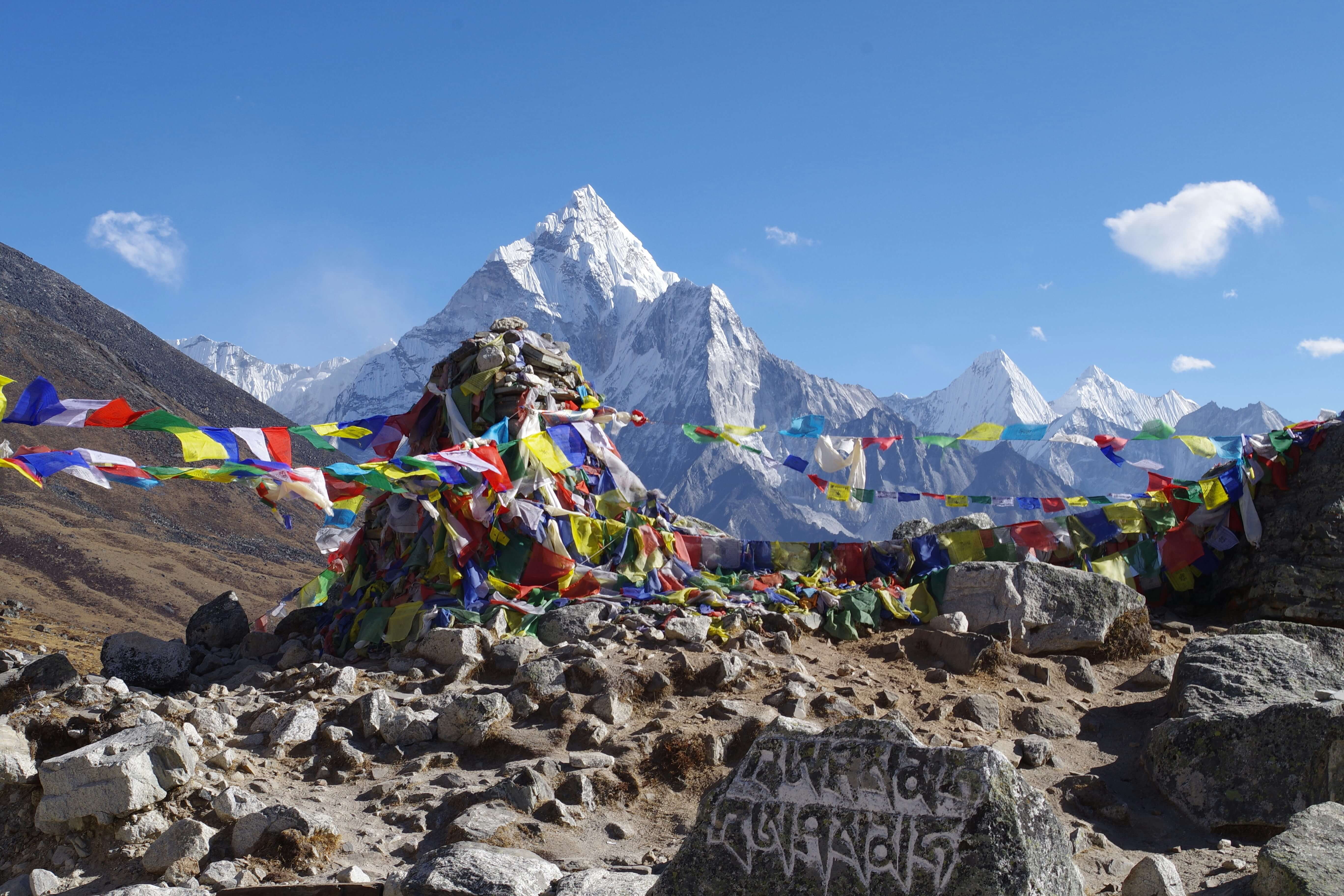
Yes, base camp itself is a picturesque spot. If its for the memorable moment or for keeping the celebrated moment of achievement, picture at Everest Base Camp is always an iconic choice to have.
Kala Patthar
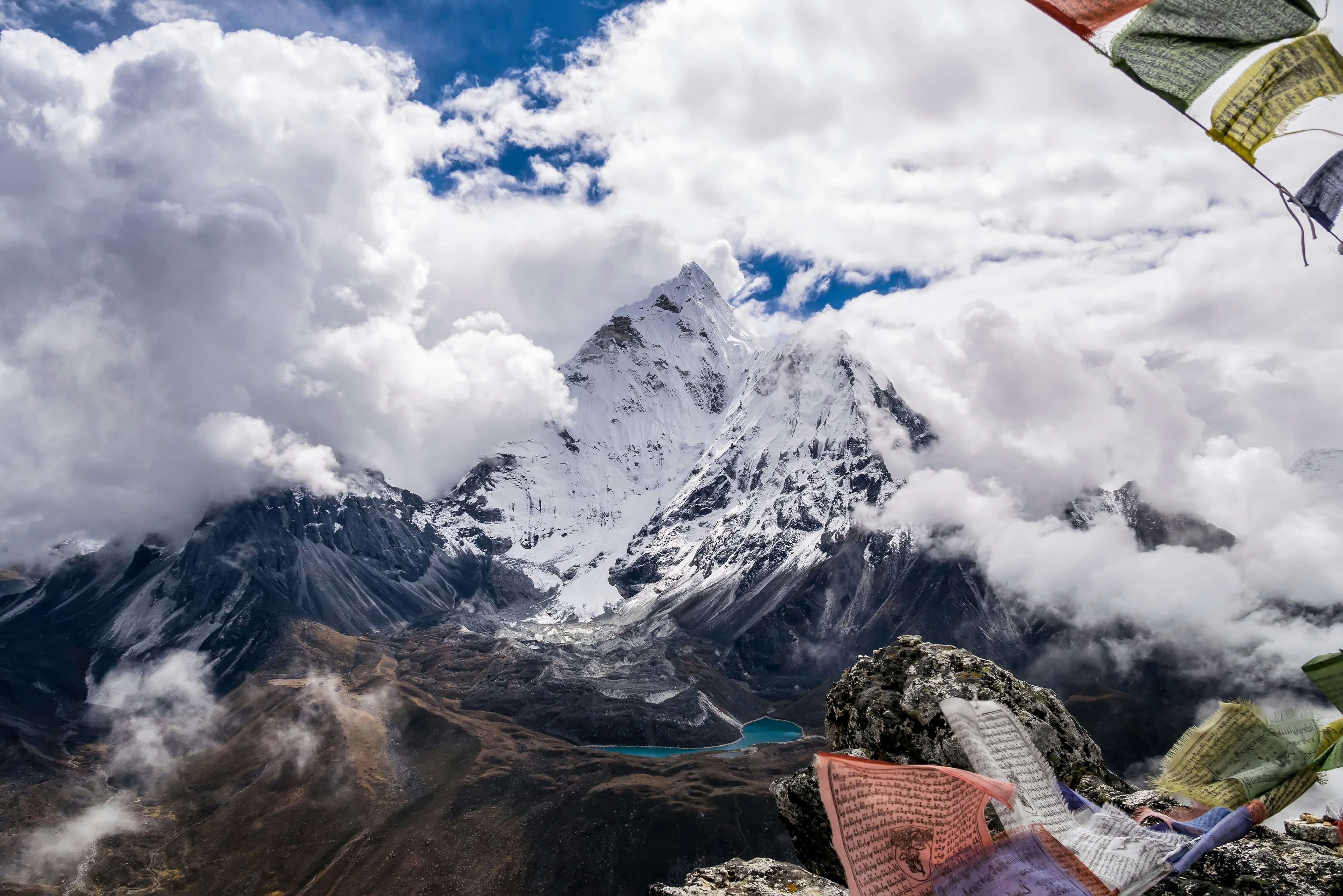
Best Time for Photo in Kala Patthar: pre-dawn to sunrise
It is the highest altitude spot in the Everest trekking trail with the elevation of 5364m, so it is a view point in it self too, which offers the panoramic close view of breathtaking Mt. Everest, Nuptse and Pumori including the Khumbu Glacier and the Khumbu Icefall and the lakes with the scenery of originating rivers. It obviously makes it a great photo spot for any of trekkers and photogenic person to capture the beautiful moment.
Namche Bazer
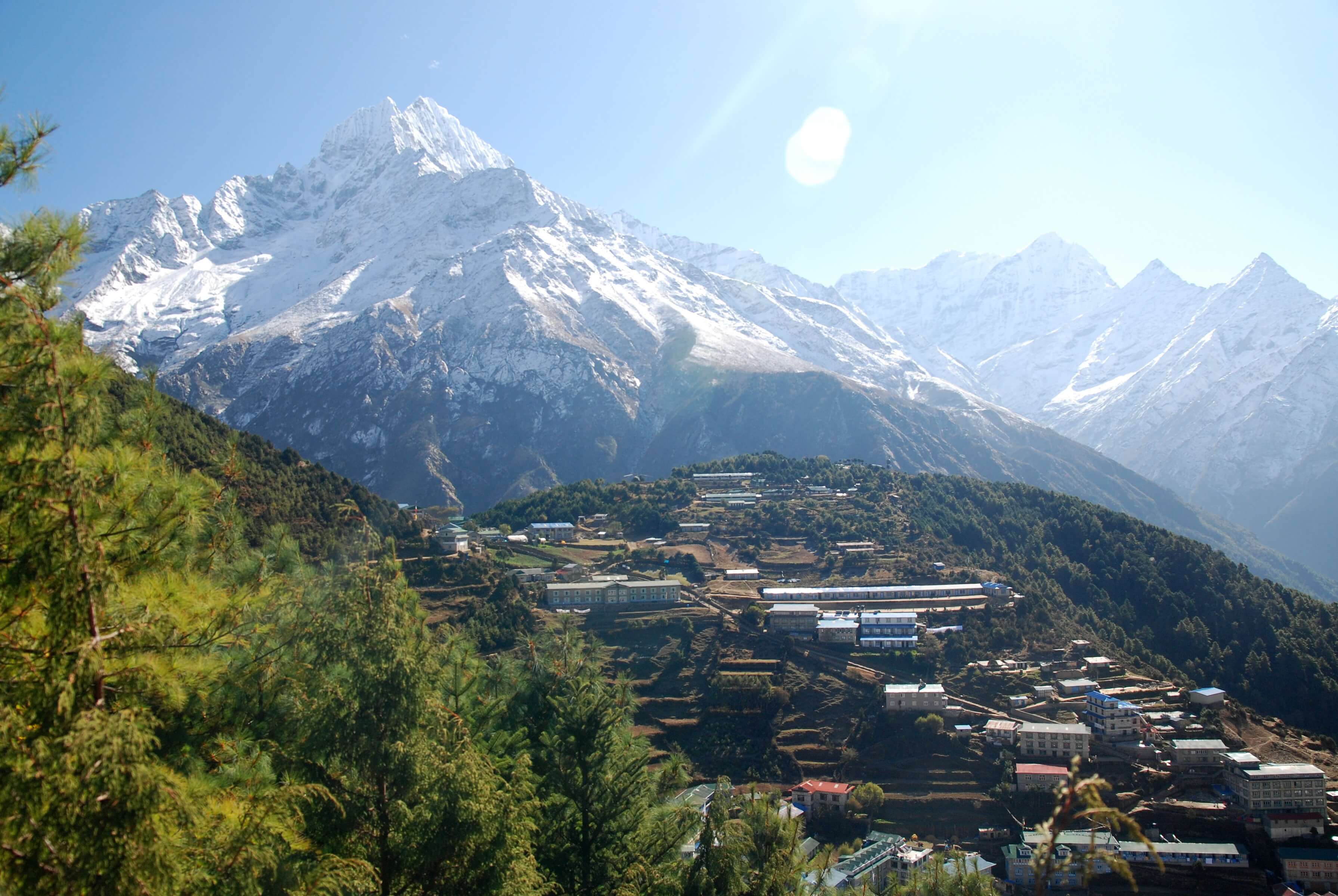
Best Time for Photo in Namche Bazer: 8 Am to 10 Am
Namche Bazer is itself an example of Himalayan town with no road acess and inside the pure terrain of Himalayas, still managing to have the restaurants, lodges, cafes, museums and more leading to a very vibrant and scenic town at the altitude of 3440m. from there you can also capture the panorama of Everest, Lhotse, and Ama Dablam.
Tengboche Monastery
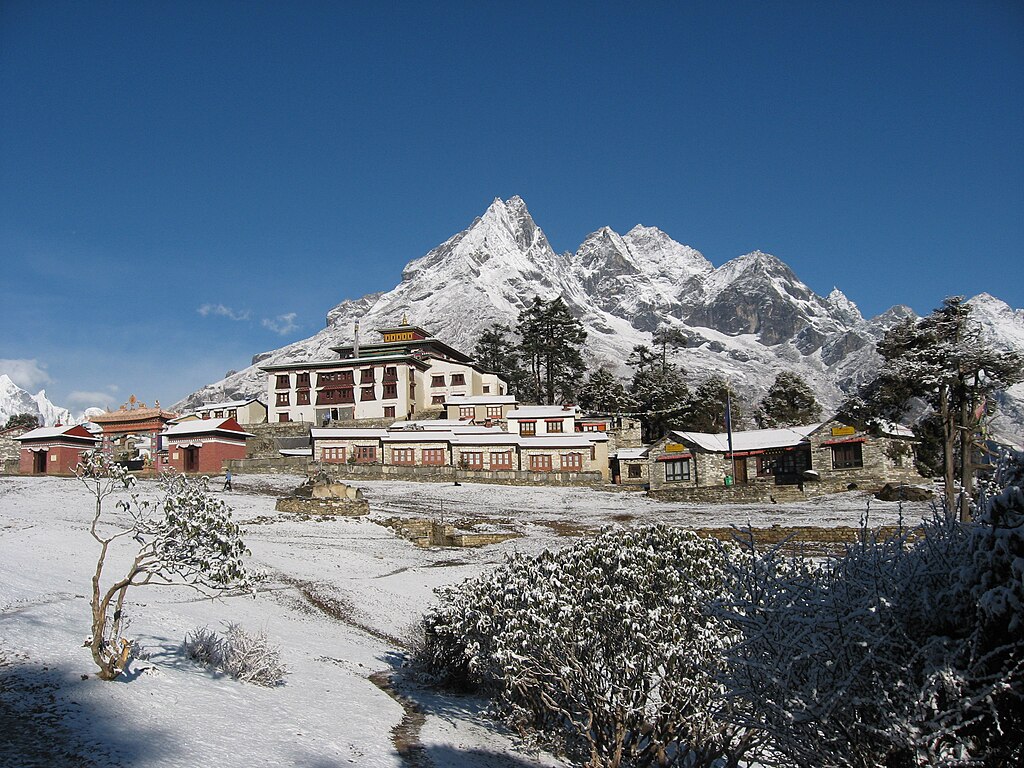
Best Time for Photo in Tengboche Monastery: 8:00Am to 9:30Am
Tengboche monastery is a popular and the largest monastery in Khumbu Region. The gompa is famous for getting the blessings from the monks for pilgrims, trekkers and mountaineers. The backdrop of snow-capped peak of Ama Dablam makes it a picturesque spot along with the traditional decor of Ghompa as well the landscapes add a bit of flavor.
Suspension Bridges
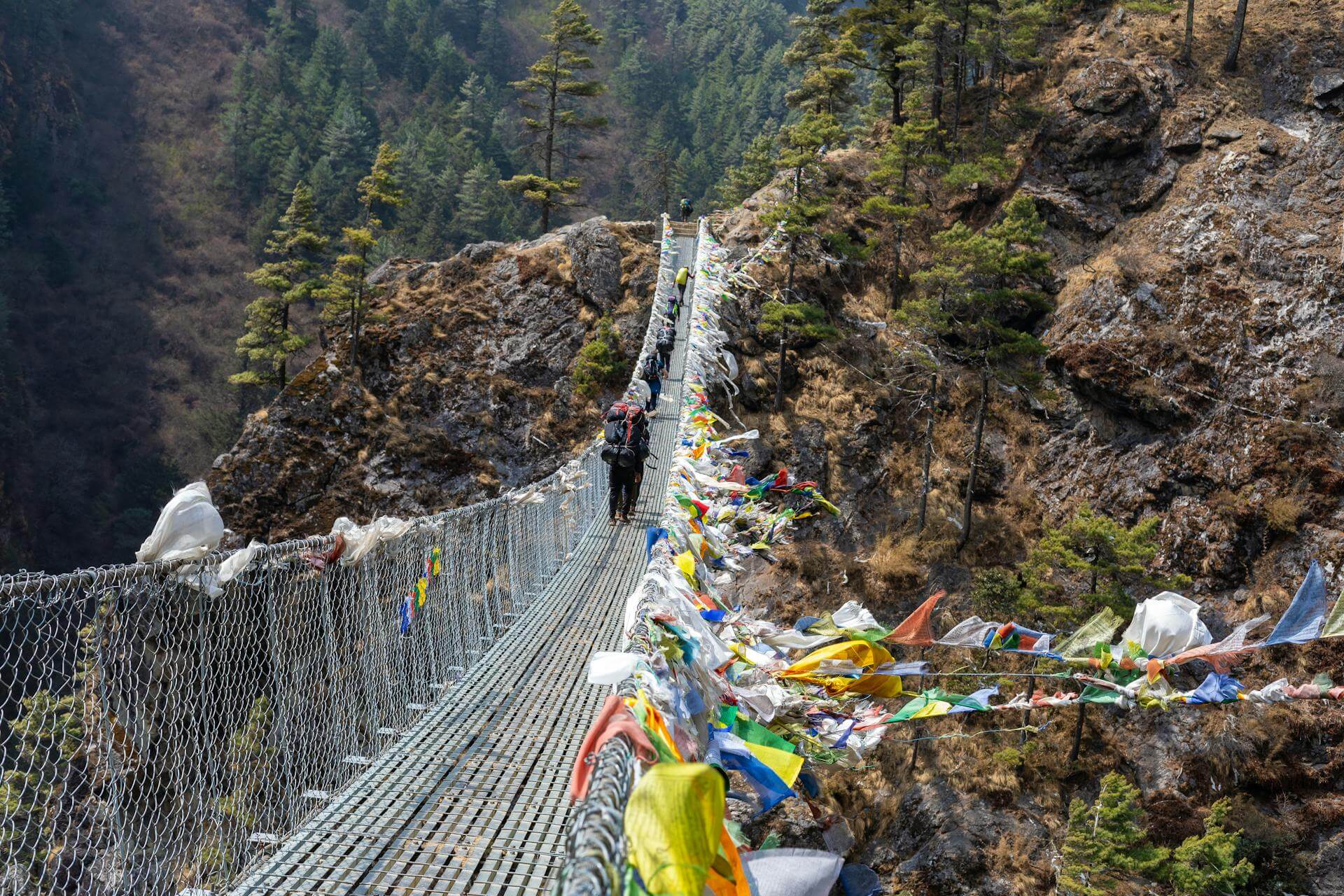
Best time for Photo in Suspension Bridges: Late morning to Mid-day
The suspension bridges are all over the different rivers and sometimes in streams too and it is always been an attraction for the travelers and trekkers due to its beauty in itself. As well the prayer flags over the bridges in Khumbu Region makes it more spiritual and adds more beauty in journey as well crossing the rivers through suspension. Mostly the Hillary Bridge near Phakding is considered and is more apricated for picturesque spot. But the suspension bridges all over Khumbu Region is really an example of beauty in a material.
Tips for you to have a great picture/for professional photography too
- Golden Hour: 1hour after sunrise, 1 hour before sunset – best for the landscape’s photography
- Avoid Harsh Light: mostly during the time of midday for portraits or shorts wit strong shadow
- Bring a polarizing portable filter if you want more professional pictures to cut haze and enhance skies
Some Final Tips for You During Everest Base Camp Trek
- Do carry a container or a water bottle which have enough space or can hold enough water for you. It is not like what we think of trekking in a cold region and may water be not that necessary as in tropical region. You will need enough water to consume to reduce several risks as well you probably encounter huge need of water consumption and the dehydration. So, it is recommended you to carry a water container for yourself than to rely on others/fellow trekkers.
- Do wear proper clothing which can properly cover your body. Everest trekking trail is a diverse nature region so, you have to cross the number of forests, terrains, cliffs, meadows and more. You can never guess what your foot encounters or what touches your skin and sometimes it can give you some fatal injuries. So, relying on proper clothing and shoes as well reliable trekking gear helps a lot to avoid such factors.
- Do not warm up or proceed any exercise more than usual, even if it is recommended by others. It can be the cause of frequent altitude sickness, especially above the altitude of 4000m above. Rather do the basic and as of your considerable exercise just enough for body focusing on your body movement and breathing.
- Respect every culture and traditions which you will see and encounter during your trekking joinery even if its strange for you. As, we already talked about the traditional and cultural richness of ethic people in Khumbu region preserved from the centuries back, so it may and can be a very different as well sometimes strange for you. But respecting culture is one of a main image of true traveller, rather immerse in them and explore the other sides of the world and authentic lifestyles.
- Follow leave no trace policy, and save the nature. Manage all the waste properly and compose them only in bins or in proper managed sites. If you are in higher altitude and if can’t find the place to compose them, then you can bring them back with you and manage them in proper waste bins or in sites.
- Carry first aid kit as an important essential with some basic medical support items. Trekking in terrains can bring some times unfortunate accidents and can be injurious, and in such conditions, it can be very helpful and supportive. Also, getting small wounds are often while having such diverse journey in nature and should be cared properly.
Some Other Best Everest Trekking journey with Shepherd Holidays
Everest Panaroma Trek
Best for scenic trek
Everest View Trek
Best for scenic viewpoints
Everest Base Camp with 3 High Passes
Best for raw adventure and rugged geography
Mani Rimdu Festival Trek
Best for Cultural immersion
Tradational Everest Base Camp trek From Jiri
Best for authentic expereince of ancient trail
or, you just can simply visit by clicking our Everest Trekking, and explore more trekking journeys and adventure activities inside Everest Region with Shepherd Holidays.
Conclusion: Final Thought
Until here, we talked and discussed about the Everest Base camp Trek and its features as well some factors to guide you properly for your next great adventure. All of this info is the collection of considering the expereince of various trekkers and the expert guides in the field as well travelers from all around the world as well our own expertise and experience form the past decades.
So, all we provided here are not just a random pick, it’s the blend of whole scenario, but what we are conveying here all about this is to insight you a fact: still this all what you are having here is the glimpse of adventure and journeys of others. You will never know what its like to be in there in-person until you’ve done it by yourself. So, we recommend you not just to rely on others stories and experience to glimpse the world.
Just get yourself out and create your own stories to tell!
If you want to join us for your next great adventure or a travel Journey. Contact Us.




